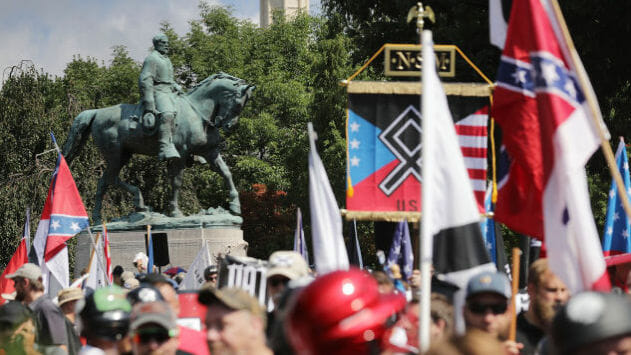Take the Confederate Monuments Down. All of Them.
Enough is enough
Chip Somodevilla / Getty
It belongs in a museum!
— Indiana Jones
While discussing Charlottesville, we are forgetting the host of the event, the statue of Robert E. Lee. Lee is dead. But his spirit marches on. Adam Serwer wrote of the late General:
When two of his slaves escaped and were recaptured, Lee either beat them himself or ordered the overseer to “lay it on well.” Wesley Norris, one of the slaves who was whipped, recalled that “not satisfied with simply lacerating our naked flesh, Gen. Lee then ordered the overseer to thoroughly wash our backs with brine, which was done.”
There are about seven hundred public Confederate monuments in America.
Take them down. All of them.
They are brine down the back.
If I seem insistent on this, I ran out of patience this weekend. By the look of it, so did everyone else. Yesterday, the people in Durham brought down the graven image of a Confederate soldier. In Atlanta, a group of protesters surrounded the Confederate memorial in Piedmont Park and spray-painted it with red. They removed a Confederate statue, “Old Joe,” in Gainesville. There were protests near monuments in Nashville, and San Antonio.
I support bringing down these images according to the letter of law, in agreement with democratic process. But down they must come all the same.
“It’s heritage, not hate.” Guess what? This is literally my heritage. I am from the South. One family from Texas, one from Tennessee. My ancestors on both sides fought for the Confederate cause. Here is what I say: take them down, forever. As Serwer writes, “Benedict Arnold was also a talented general; Americans do not erect memorials to him in their public squares.”
Take them down.
I am from the South, and it is humiliating to deal with this reactionary, caveman bullshit. This does not reflect the people I love, the people I know, the people I grew up with. The greatest Southern virtue is politeness. These monuments are not polite. Take them all down. All seven hundred of them. Take them down in Georgia, take them down in Texas, and in Alabama. And sure as hell take them down in Montana.
-

-

-

-

-

-

-

-

-

-

-

-

-

-

-

-

-

-

-

-

-

-

-

-

-

-

-

-

-

-

-

-

-

-

-

-

-

-

-

-









































